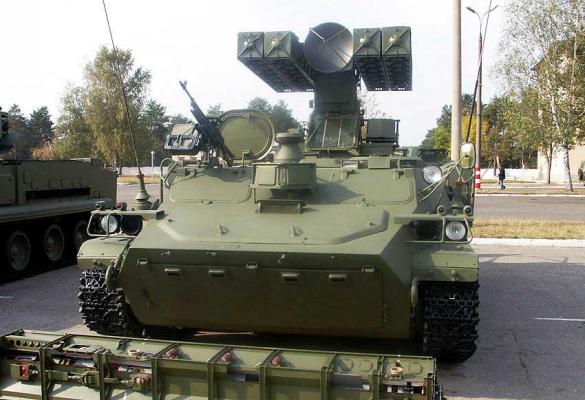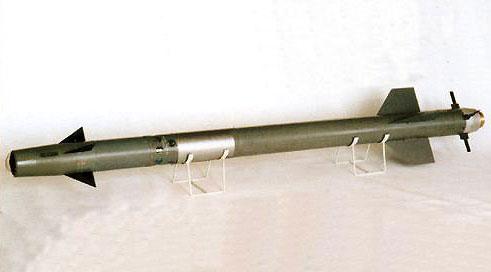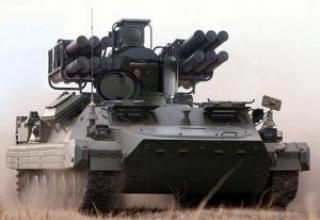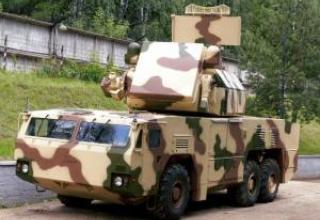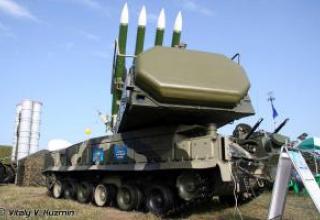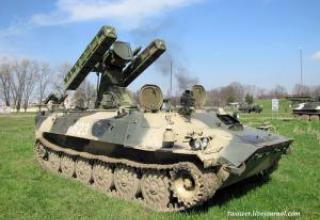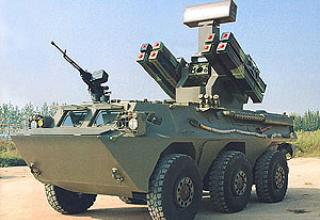In the period from 1977 to 1989, the Arrow-10SV anti-aircraft missile system was repeatedly upgraded, primarily by improving the missile's homing head, missile launch equipment, development of equipment for automated receiving and processing of target designation. The samples created as a result were designated: "Arrow-10M" (9K35M), "Arrow-10M2" (9K35M2), "Arrow-10M3" (9K35M3).
The last version of the upgraded complex, the Arrow-10M3, adopted for service in 1989, has an extended kill zone, has a high efficiency and interference immunity under conditions of intensive organized optical interference, provides firing at all types of low-flying air targets (aircraft, helicopters, cruise missiles, remotely piloted vehicles). The development of the complex was carried out by the cooperation of enterprises that developed the Arrow-10 SAM system and its other modifications.
In the west, the complex was designated SA-13 "Gopher".
Composition:
Arrow-10M" 9K35M SAM system (see diagram)
Adopted for service in 1979. Improved homing head of SAM and missile launching equipment of combat vehicles 9A34 and 9A35. The GSN of the upgraded 9M37M missile (see description) selectively selected target and organized optical interference by trajectory characteristics, which reduced the efficiency of thermal trap interference. In terms of all other characteristics, the 9K35M system remained similar to the Arrow-10SV, except for some increase (by 2-3 seconds) in operating time when firing under conditions of interference.
Unlike the 9M37M, the previously produced 9M37M does not have the ability to adjust to organized optical interference and does not have a peculiar memory in the direction and speed of the target, as in the autopilot of the 9M37 missile there is no interference selection block, which performs the adjustment of interference from the target, and the atatism block, which increases the reliability of holding the homing head under the influence of disturbances acting at launch. Other tactical and technical data of 9M37 are the same as that of 9M37.
The marking of 9M37 differs from that of 9M37 by the absence of the letter M in the missile index. Missiles 9M37 and 9M37M have no other external differences than those indicated in the markings.
Arrow-10M2" 9K35M2.
The result of further modernization of "Arrow-10M" complex. Range tests of the prototype of the complex were carried out at the Dongguz range (range manager V.I. Kuleshov) in July-October 1980 under the guidance of a commission headed by E.S. Timofeev.
In the course of modernization, the following improvements were made:
- 9B179-1 automatic target designation reception equipment has been developed and introduced into the combat vehicles of the complex from the battery command post PU-12M and the command post of the commander of the air defense regiment Ovod-M-SV SPRU-1 (SPRU-1M "Sborka-M") or from detection radars equipped with ASPD-U equipment,
- Targeting equipment was developed and introduced, which provided automated pointing of the launcher at the target,
- Polyurethane foam floats were introduced to overcome water obstacles, hinged from combat vehicle sides, with a full SAM kit and a machine gun.
- An additional radio station R-123M has been installed to provide reception of telcode information.
In addition, the Arrow-10M2 SAM system was equipped with: special power supply system (SEP), 9B385M missile launch equipment, "Svoi Zhuja" recognition system, passive radio - 9C16 direction finder, TNA-3 tank navigation equipment and DP-3B device.
As a result of the tests it was found that in the specified kill zone with the use of the automated target designation reception and debugging (TSU) (with self-direction of the SAMs along the photocontrast channel without interference) the Arrow-10M2 SAM system ensures the effectiveness of firing one SAM against fighters at counter courses - 0, 3 at a range of 3.5km and 0.6 in the range from 1.5km to the nearest boundary of the kill zone, which exceeded the effectiveness of the Strela-10M system by 0.1-0.2 at the same ranges. This was achieved by increasing the target detection range from 6.8 to 8.4 km, reducing the operating time at the CC from 8.5 to 6.5 s, increasing the target omittance frequency from 0.7 to 1, reducing the time it took for the CC to reach the operator (by 2.5 times), and for the CC to operate (by 2 times).
Arrow-10M3" 9K35M3 SAM systems
The 9A34M3 and 9A35M3 armored vehicles included in the SAMs had a new 9Sh127M optical sighting system with two channels with variable field of view and magnification: a wide field of view with a 35° field of view and a 1.8° magnification and a narrow field of view with a 15° field of view and a 3.75° magnification (which provided an increase in the detection range of small targets by 20-30%), as well as improved equipment for launching SAMs, which enabled a more reliable capture of the missile's SLV target.
The new 9M333 ZUR (see description), compared to the 9M37M missile, had a slightly modified engine and container, as well as a new CNS with three receivers in different spectral ranges: photocontrast, infrared (thermal) and interference with the logical target selection against the background of optical interference on the spectral and trajectory characteristics, which significantly increased the interference immunity of the complex. The new autopilot provided a more stable operation of the CNS and the control loop of the SAM as a whole in different modes of rocket launch and its flight depending on the interference (background) situation. The length of the missile was increased to 2.23 m.
The new non-contact explosive device of the LRS was made on the basis of four pulsed laser emitters, an optical circuit forming an eight-beam directional diagram and a receiver of signals reflected from the target. The doubled number of beams compared to 9M37 ZUR has increased the effectiveness of targeting small targets.
The beam head of ZUR 9M333 had an increased mass (5 kg instead of 3 kg in ZUR 9M37) and was equipped with longer cross-section and longer length rods. Due to the increased breaking charge, the velocity of splinters was increased. The contact fuse consisted of a safety detonator, a self-liquidation trigger, a target contact sensor and a transfer charge.
The 9M333 and 9M37M missiles could be used in all modifications of the Strela-10 system.
The complex provided not less than 9K35M2 SAMs area and probability of destruction at altitudes from 25 to 3500 m of aircraft flying on counter courses with speeds up to 415 m/s (up to 310 m/s - inhaling) and helicopters with flight speeds up to 100 m/s. Winged rockets with speeds up to 200-250 m/sec and UAVs with speeds from 20 to 300 m/sec were hit at altitudes from 10 to 2500 m (in photo contrast channel - only above 25 m).
The ranges and probabilities of hitting F-15 fighter-type targets flying at 300 m/s at altitudes and up to 1,000 m at 2.5 s optical interference rate were reduced to 65% in the photocontrast channel and 30% and 50% in the thermal channel, respectively. In the rest of the kill zone, as well as when shooting noise downwards in the whole zone, the decrease in range and probability of injury did not exceed 25%.
In the 9K35M3 complex, it became possible to reliably capture the target with the 9M333 homing head prior to launch in the presence of optical interference.
Functioning of the complex was provided with the help of the 9B839M testing machine, 9B915 maintenance machine and 9I111 external power supply system.
Characteristics:
| Complex | Arrow 10M | Arrow 10M2 | Arrow 10M3 |
| Rocket | 9М37М | 9М37M | 9М37/9M333 |
| Defeat zone, km | |||
| - at a distance | 0,8..5 | 0,8..5 | 0,8..5 |
| - in height | 0,025..3,5 | 0,025..3,5 | 0,01..3,5 |
| - as defined in | up to 3 | up to 3 | up to 3 |
| Probability of hitting a single ZUR fighter. | 0,1..0,5 | 0,3..0,6 | 0,3..0,6 |
| Maximum speed of the targets to be hit (up/down), m/s | 415/310 | 415/310 | 415/310 |
| The reaction time, s | 8,5 | 6,5 | 7,0 |
| Average flight speed of ZUR, m/s | 517 | 517 | 550 |
| Weight of the ZUR, kg | 40 | 40 | 41 |
| Weight of combat unit, kg | 3 | 3 | 5 |
| The number of SSDs on a combat vehicle | 8 | 8 | 8 |
| Year of adoption | 1979 | 1981 | 1989 |
Testing:
Strela-1 and Strela-1M complexes were widely exported by the USSR abroad. They were supplied to the countries-participants of the Warsaw Pact, to Yugoslavia, to the states of Asia (Iraq, Syria, North Yemen, India, Vietnam), Africa (Algeria, Angola, Benin, Egypt, Guinea, Guinea-Bissau, Libya, Madagascar, Mali, Mauritania, Mozambique) and Latin America (Cuba, Nicaragua), confirming their rather high efficiency and ease of use during military conflicts and during training firing.
The first use of the Arrow 1 SAM system was in the Bekaa Valley in southern Lebanon in 1981. In December 1983, these SAMs were shot down by American A-6E and A-7E aircraft (the latter, probably, was hit by portable SAMs of Strela-2 family). In the same year, several Arrow 1 SAM systems were captured by South African invaders in southern Angola.
Sources:
- Зенитные ракетные комплексы ПВО СВ. Техника и вооружения №5-6.99.
- Ракета 9М37М (9М37). Техническое описание и инструкция по эксплуатации. - М.: Воениздат,1980. - С.6-8,10-12,18.
- ARMY AIR DEFENCE
- Зенитная управляемая ракета 9М333 для комплекса «СТРЕЛА-10М3» (Завод им.В.А.Дегтярева)
